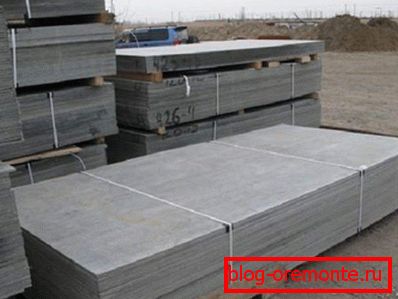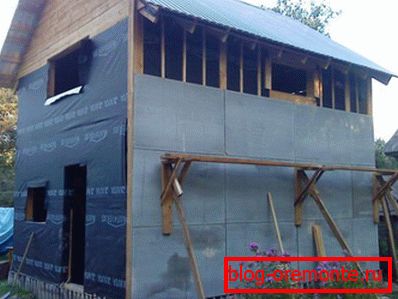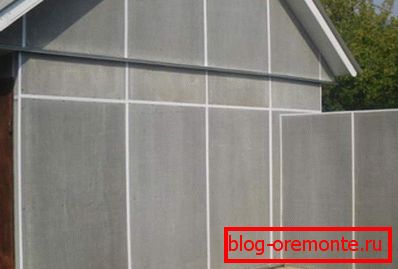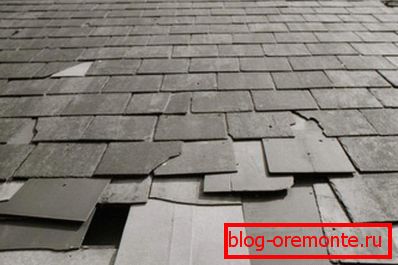Flat slate - dimensions and specifications
Speaking of slate, everybody imagines roofing material and a wavy gray surface, but sheets of asbestos cement, which have no relief, are denoted by the same term. Flat slate differs from its more popular counterpart only in form, having the same composition and method of production. This article will tell about its types, characteristics and methods of use in the construction of houses and roofs.
Composition and types
Flat slate, as a wave, produced from sweep Portland cement with asbestos fiber and water. The proportion of asbestos in the composition is 18%, that mineral increases the strength and impact strength of the sheet. Slate flat is divided into 2 subspecies, depending on the method of production:
- Unpressed. The technical characteristics of a non-pressed asbestos cement sheet are slightly worse than those of a pressed sheet. The strength of the material is 18 MPa, the density of 1.6 g / cu. cm, impact strength 2.0 kJ / sq. m. Unpressed flat slate retains its properties for 25 cycles of defrosting and freezing. But the residual strength of the sheet is 2 times higher than that of the extruded.

- Pressed. Asbestos cement slate produced by pressing is in great demand in private construction. The reason for this are high specifications. The sheet has a strength of 23 MPa, a density of 1.8 g / cu. cm, impact strength 2.5 kJ / sq. m. Extruded flat slate without loss of performance withstands 50 continuous cycles of freezing and defrosting. However, after this the sheet retains only 40% of the initial strength.

Important! Experienced builders prefer pressed flat slate, since the technical characteristics of this material allow it to be used in difficult conditions with high humidity, temperature drops and load. In addition, the pressed sheet of asbestos cement has more stable dimensions, since the error allowed in the production is 4 mm, against 10 mm for non-pressed.
Advantages and disadvantages
Slate flat is used in many areas of construction, it is considered one of the most popular materials for roofing, the construction of outbuildings, facades, walls. So popular asbestos sheet make the following advantages:
- Affordable price. Sheet size 1.5x1.0 m, whose thickness is 10 mm, costs in hardware stores within 300-350 rubles. Pressed flat slate is considered the cheapest material used for roofing. The price of this coating is 2-2.5 times lower than the profiled or metal tile.
- Durability. Judging by the buildings of the Soviet era, it can be assumed that the life of the asbestos cement sheet with a thickness of 10 mm with proper maintenance exceeds 30-40 years, declared by the manufacturers.
- Resistance to fire. Due to its high refractory properties, a sheet of asbestos cement is used as insulation for installation sites of heating equipment or chimneys.
- Strength. Asbestos cement pressed sheet with a thickness of 8-10 mm can easily withstand the average weight of a person, so he is not afraid of mechanical damage.
- Ease of installation and repair. Installation and reconstruction of slate sheet does not require special tools and skills. You can replace the damaged sheet with your own hands without disassembling the roof covering completely.


- Versatility. The sizes of flat slate are various. Manufacturers produce materials with a sheet thickness of 6, 8, 10 and even 30 mm, 1.5 - 3 m long, 1 - 1.5 m wide. The most common damage to asbestos cement occurs when builders cut flat slate. Dimensions are selected to perform as little as possible cutting.

Important! Asbestos, from which slate is produced, carries a potential hazard to human health. Getting into the respiratory tract and mucous membranes, it irritates them, causes coughing, itching. However, asbestos dust is released only during cutting and making holes in the slate. To protect against it during work, use a respirator dipped in water, glasses.
The disadvantages of asbestos cement are considered potentially harmful composition, high weight and low resistance to moisture penetration. The weight of a sheet of slate, depending on the size is 25-30 kg. Considering how much it weighs, for installation they will equip a reinforced crate, a reliable rafter frame. The problem with waterproofing is solved by applying a special paint that gives an attractive color and creates a protective film that does not let the water through.

Slate roof
Flat slate is used for the construction of roofs as a roofing material. This process has a number of features:
- For roofing use extruded flat slate with a thickness of 8-10 mm. Thinner sheets do not have sufficient strength, and thick too heavy.
- Since the weight of a sheet of asbestos cement with a thickness of 10 mm 1.5x1.0 m is 29 kg, the roof frame and roof lath are reinforced. Rafters with a section of 100x150 mm are installed in increments of no more than 80-100 cm, and the battens of the batten are made of 50x50 mm boards. All wood is treated with antiseptic composition.

- Sheets are laid down to avoid long longitudinal seams, poorly protected from moisture penetration. Horizontal rows of flat slate are mounted in a joint, and vertical rows with overlap to half the length.
- As fasteners used stainless steel screws with a press washer and rubber seal. The caps of the screws do not deepen, but leave a small gap in order to avoid damage. In order not to split the sheet, the holes are drilled no closer than 70-100 mm from the edge.

- To give the roof the desired shade and enhance protection against moisture penetration, use a special paint for slate. Before applying the surface primed.

Note! The hammer and nails used to install the wave slate are not suitable for flat. Too strong hammer blow is often the cause of splitting sheets. If the installation is performed by an inexperienced master, the material is purchased with a margin of 10-15% for rejection.
The excellent performance characteristics of flat asbestos cement, as well as modern production technologies, make it possible to create a durable, spectacular roofing coating, the appearance of which cannot be compared with a monotonous wavy slate.